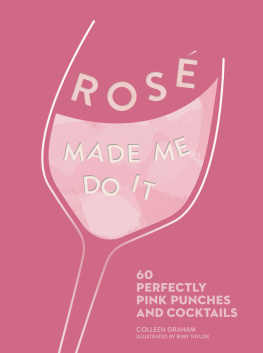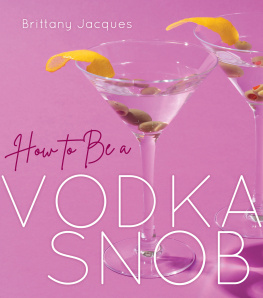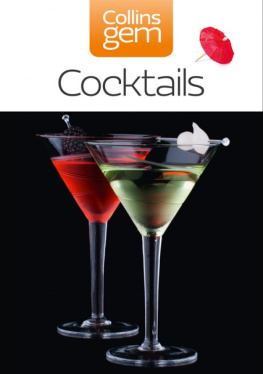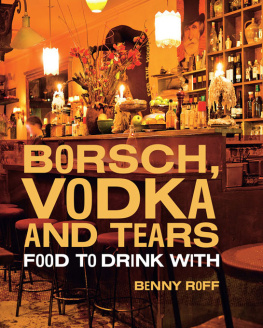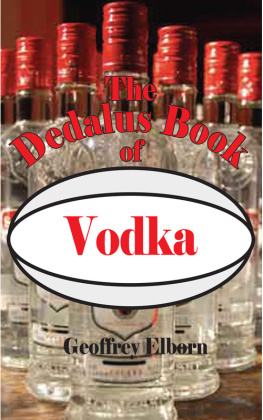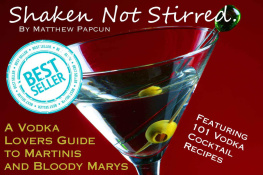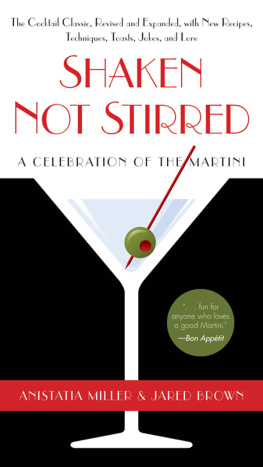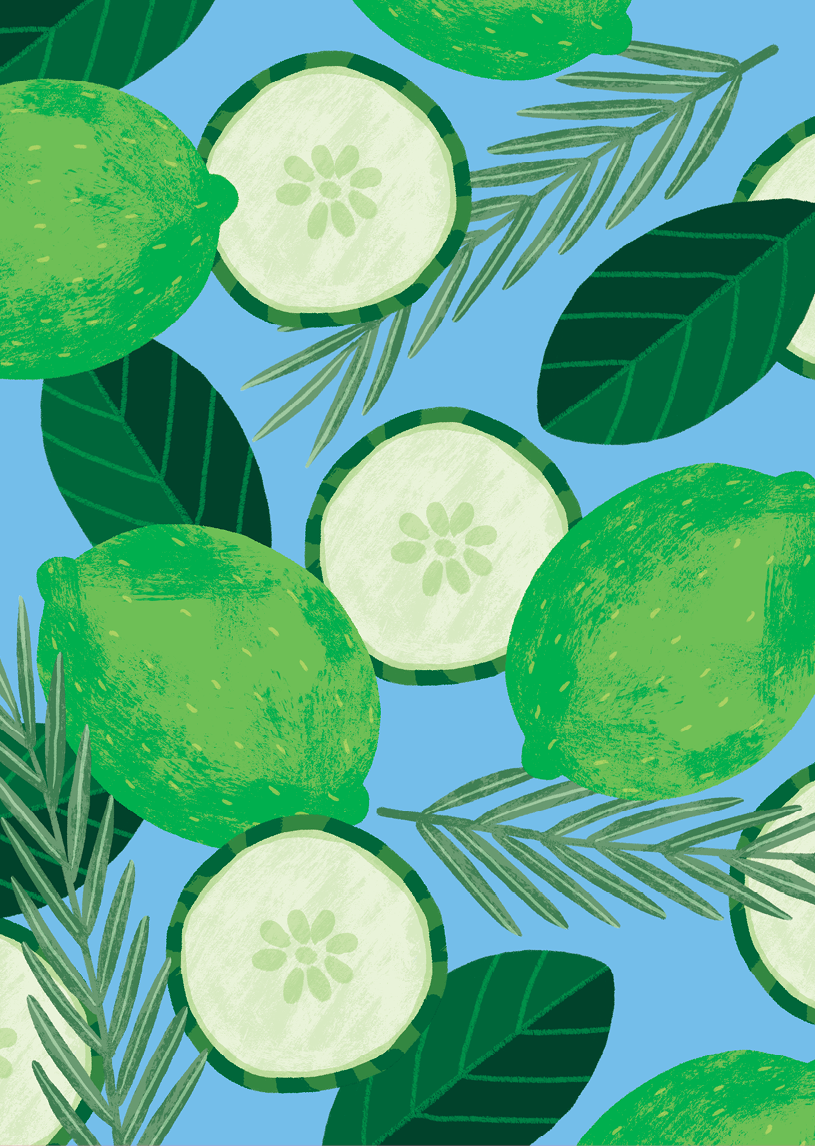Vodka Made Me Do It copyright 2022 HarperCollinsPublishers.
All rights reserved. No part of this book may be used
or reproduced in any manner whatsoever without written permission
except in the case of reprints in the context of reviews.
Andrews McMeel Publishing
a division of Andrews McMeel Universal
1130 Walnut Street, Kansas City, Missouri 64106
www.andrewsmcmeel.com
ISBN: 978-1-5248-8098-9
Library of Congress Control Number: 2022933424
ATTENTION: SCHOOLS AND BUSINESSES
Andrews McMeel books are available at quantity discounts with bulk purchase for educational, business, or sales promotional use. For information, please email the Andrews McMeel Publishing Special Sales Department: .
DISCLAIMER:
This book features recipes that include the optional use of raw eggs.Consuming raw eggs may increase the risk of food-borne illness. Individuals who are immunocompromised, pregnant, or elderly should use caution. Ensure eggs are fresh and meet local food-standard requirements.
Please drink responsibly.
CONTENTS
INTRODUCTION
The most popular liquor in the world, vodka is easy to discount as the flavorless, odorless spirit its so often described as. While to some extent thats a fair assessment, the last few decades have proven that vodka is anything but boring. The liquor is continually adapting to market trends, and it is now the most mixable distilled spirit youll find, which is why it makes the ideal base for cocktails.
While vodka is often seen as a liquor used primarily for its alcoholic buzz, its not just water with a kick. That may be true for some vodkas, but if you take the time to taste enough brands youll discover subtle nuances. Some have a delicate floral bouquet, those made from corn or wheat may have an underlying sweetness, rye vodkas may be a bit spicy, and potato vodkas are almost buttery. Vodka can be medicinal or have a silky or oily texture. With all of these tasting notes, however, smoothness has long been the measure of good vodka. Todays vodka market doesnt relegate that desired aspect to the top-shelf brands, either. You can find some excellent budget-friendly options that are just as smooth as any high-priced vodka.
All of that makes now a great time to reintroduce yourself to vodka, and cocktails are an excellent way to do this. Within this book youll find tried-and-true recipes along with fun twists on the worlds best-known cocktails (not all of which were originally intended for vodka), as well as several classic drinks. My intention is to extend the perception of whats possible with this liquor and encourage everyone to explore its fascinating possibilities.
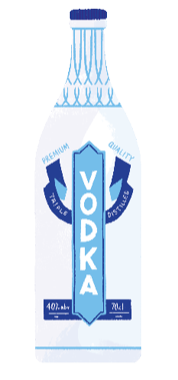
One of the best ways for this is through homemade infusions, and youll find plenty of ideas for adding flavor to your favorite vodka (see ). Sure, you can buy citrus or vanilla vodka off the shelf, but theres a certain satisfaction to making even these common variations at home because you can control every ingredient and develop the flavors to perfectly match your taste. Some of these varieties are made by just a few companies and are tricky to find, while others are only obtainable through a DIY project. The majority of these drinks will also work with straight vodka or another infusion, so mix and match to your hearts content.
Although this is really just a primer on mixing cocktails, I also hope to teach you a few tricks to create better drinkssmall tips like using fresh produce, homemade mixers, clean ice, and some suggestions for a few basic tools and techniques that will improve every drink you make. Most importantly, any cocktail should be adapted to suit your personal taste. Add more citrus or sweetener, cut back on the soda, pour an extra shot of vodka... whatever you do, I wont be offended. After all, youre drinking it!
What is vodka?
In the lexicon of distilled spirits, vodka is an open book thats interpreted by each distiller. Technically, vodka is clear liquor distilled from any starchy or sugary ingredient. Traditionally, this was a grain such as rye or wheat, potatoes, or sugar beet molasses. Modern vodkas are distilled from corn, rice, grapes or other fruits, sorghum, soy, or even just straight sugar.
Vodkas possibilities can reach the boundaries of other liquors. Molasses and sugar vodkas can have a rum-like taste, grain vodkas are similar to unaged whiskey (moonshine), and fruit-based vodkas are not entirely different from brandy except they dont spend time in a barrel. Vodka really is the catch-all distilled spirit. As long as its clear and neutrally flavored, everything that doesnt conveniently fit into another category or adhere to certain standards often gets classified as vodka.
The origins of vodka
The exact birth of vodka is unclear and subject to conflicting narratives. Beyond oral traditions and lost written records, any history that pertains to intoxicating beverages (whether liquor or cocktails) should take the nature of the beast into account.
The first distilled spirits date back to ancient times. While no hard evidence exists, someone somewhere in the world once had the thought of introducing fermented beer or wine to intense heat and capturing the vapors to create a more potent beverage. It may even have happened simultaneously in multiple regions. By the twelfth century, Europeans were refining the technique of creating agua ardens (burning water) and aqua vitae (water of life). That knowledge was passed along trade routes to Europes Baltic region, where grains like rye and wheat were bountiful, inexpensive commodities.
Both Poland and Russia claim to be the birthplace of vodka, and each nation might have learned about distillation through interactions with Italians during the twelfth and thirteenth centuries. There may have been a Mongolian influence from the other side of Russia as well. The first written account of wdka was in a 1405 Polish court document, while in Russia, voda (translated to little water) made its initial print appearance in the early 1500s.
By the sixteenth century, vodka was the national drink of both Russia and Poland. It was cheap to make from whatever grains were available, so, for instance, potato vodka emerged in Poland. In the Russian Empire, the government quickly figured out that stronger alcohol led to higher taxes, so vodka was promoted to the people over lighter beers and wines (at times, even forced on peasants who wished to abstain) and became one of the largest revenue sources until the world wars (both Tsar Nicholas II and Vladimir Lenin were prohibitionists). Its popularity came back a bit in the mid-twentieth century, but (while not banned) vodka was discouraged by Mikhail Gorbachev.

During this troubled time, several Russian vodka distillers fled and brought their craft to Europe and America. Much of the liquors global success is due to Vladimir Smirnov. After emigrating to France, the exiled Russian vodka-maker teamed up with an American entrepreneur and started a market for vodka in the United States. Smirnoff Vodka was distilled in Connecticut, and by the 1950s a successful advertising campaign had made it a household name.


